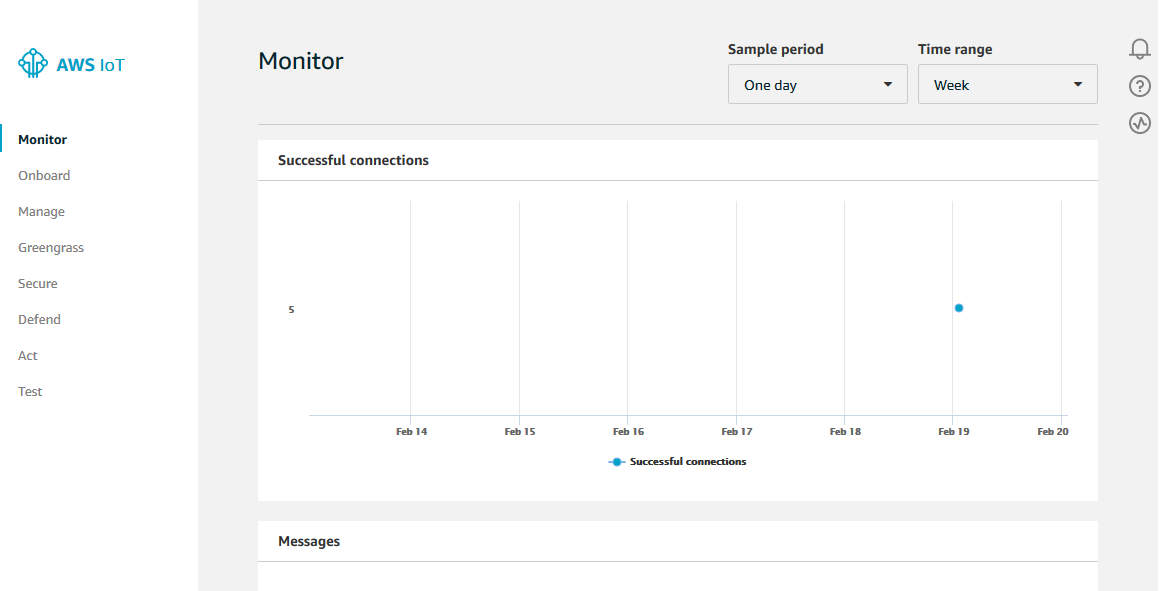End of support notice: On December 15, 2025, AWS will end support for AWS IoT Analytics. After December 15, 2025, you will no longer be able to access the AWS IoT Analytics console, or AWS IoT Analytics resources. For more information, see AWS IoT Analytics end of support.
Ingesting data to AWS IoT Analytics
If you have a channel that routes data to a pipeline that stores
data in a data store where it can be queried, then you're ready to
send message data into AWS IoT Analytics. Here we show two methods
of getting data into AWS IoT Analytics. You can send a message
using the AWS IoT message broker or use the AWS IoT Analytics
BatchPutMessage API.
Using the AWS IoT message broker
To use the AWS IoT message broker, you create a rule using the AWS IoT rules engine. The rule routes messages with a specific topic into AWS IoT Analytics. But first, this rule requires you to create a role which grants the required permissions.
Creating an IAM role
To have AWS IoT messages routed into an AWS IoT Analytics channel, you set up a rule. But first, you must create an IAM role that grants that rule permission to send message data to an AWS IoT Analytics channel.
Run the following command to create the role.
aws iam create-role --role-name myAnalyticsRole --assume-role-policy-document file://arpd.json
The contents of the arpd.json file should look like the
following.
{ "Version": "2012-10-17", "Statement": [ { "Effect": "Allow", "Principal": { "Service": "iot.amazonaws.com" }, "Action": "sts:AssumeRole" } ] }
Then, attach a policy document to the role.
aws iam put-role-policy --role-name myAnalyticsRole --policy-name myAnalyticsPolicy --policy-document file://pd.json
The contents of the pd.json file should look like the
following.
{ "Version": "2012-10-17", "Statement": [ { "Effect": "Allow", "Action": "iotanalytics:BatchPutMessage", "Resource": [ "arn:aws:iotanalytics:us-west-2:your-account-number:channel/mychannel" ] } ] }
Creating a AWS IoT rule
Create an AWS IoT rule that sends messages to your channel.
aws iot create-topic-rule --rule-name analyticsTestRule --topic-rule-payload file://rule.json
The contents of the rule.json file should look like the following.
{ "sql": "SELECT * FROM 'iot/test'", "ruleDisabled": false, "awsIotSqlVersion": "2016-03-23", "actions": [ { "iotAnalytics": { "channelName": "mychannel", "roleArn": "arn:aws:iam::your-account-number:role/myAnalyticsRole" } } ] }
Replace iot/test with the MQTT topic of the messages that should be routed. Replace the channel name and
the role with the ones you created in the previous sections.
Sending MQTT messages to AWS IoT Analytics
After you have joined a rule to a channel, a channel to a pipeline, and a pipeline to a data store, any data matching the rule now flows through AWS IoT Analytics to the data store ready to be queried. To test this, you can use the AWS IoT console to send a message.
Note
The field names of message payloads (data) that you send to AWS IoT Analytics.
-
Must contain only alphanumeric characters and underscores (_); no other special characters are allowed.
-
Must begin with an alphabetic character or single underscore (_).
-
Cannot contain hyphens (-).
-
In regular expression terms: "
^[A-Za-z_]([A-Za-z0-9]*|[A-Za-z0-9][A-Za-z0-9_]*)$". -
Cannot be greater than 255 characters
-
Are case-insensitive. Fields named
fooandFOOin the same payload are considered duplicates.
For example, {"temp_01": 29} or
{"_temp_01": 29} are valid, but
{"temp-01": 29},
{"01_temp": 29} or
{"__temp_01": 29} are invalid in
message payloads.
-
In the AWS IoT console
, in the left navigation pane, choose Test. 
-
On the MQTT client page, in the Publish section, in Specify a topic, type
iot/test. In the message payload section, verify the following JSON contents are present, or type them if not.{ "message": "Hello from the IoT console" } -
Choose Publish to topic.

This publishes a message that is routed to the data store you created earlier.
Using the BatchPutMessage API
Another way to get message data into AWS IoT Analytics is to use the BatchPutMessage API command. This method does not require that
you set up an AWS IoT rule to route messages with a specific topic to your channel. But it does require that the device
which sends its data/messages to the channel is capable of running software created with the AWS SDK or is capable
of using the AWS CLI to call BatchPutMessage.
-
Create a file
messages.jsonthat contains the messages to be sent (in this example only one message is sent).[ { "messageId": "message01", "payload": "{ \"message\": \"Hello from the CLI\" }" } ] -
Run the
batch-put-messagecommand.aws iotanalytics batch-put-message --channel-name mychannel --messages file://messages.json --cli-binary-format raw-in-base64-outIf there are no errors, you see the following output.
{ "batchPutMessageErrorEntries": [] }